Sand and salt are your phone camera's worst enemies at the beach. Sand's tiny, sharp particles can scratch lenses and infiltrate delicate mechanisms, while salt causes corrosion and degrades protective coatings. Both can block camera ports, interfering with focus and light. Even water-resistant phones aren't immune to these threats. Sand acts like sandpaper, damaging surfaces, while salt creates a corrosive mixture when combined with moisture. Over time, this duo can greatly impact your camera's performance, leading to blurry images and reduced clarity. Proper protection and cleaning techniques are essential to keep your phone's camera safe from these beach hazards. Dive deeper to uncover more about safeguarding your device.
Sand's Abrasive Nature

On the beach or in the desert, sand poses a serious threat to your phone's camera. Sand particles are tiny, sharp, and abrasive, capable of scratching delicate camera lenses and sensor surfaces. When you're in sandy environments, these minuscule grains can easily find their way into your phone's crevices, including the camera area.
Even if your phone is water-resistant, it's not sand-proof. The fine particles can work their way past seals and gaskets, potentially causing internal damage. As you handle your phone, sand trapped between your fingers and the device can act like sandpaper, gradually wearing down protective coatings on the camera lens.
The camera's moving parts, such as the autofocus mechanism and optical image stabilization system, are particularly vulnerable. Sand can interfere with these components, leading to focusing issues or stabilization failures. If sand gets inside the lens assembly, it can cause permanent scratches or leave visible specks in your photos.
To protect your phone's camera from sand damage, always use a protective case, avoid exposing your device in windy conditions, and clean it carefully after beach outings.
Salt Corrosion Effects
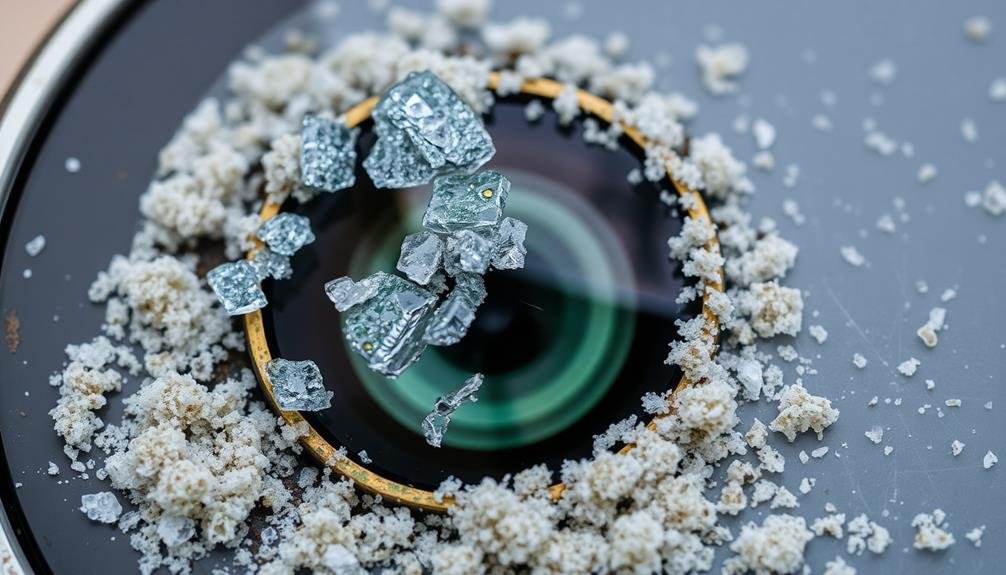
Salt poses a significant threat to your phone's camera.
It can corrode metal lens components, degrade electrical connections, and damage protective coatings.
These effects can lead to reduced image quality, malfunctioning camera features, and potentially irreparable damage to your device's camera system.
Corrodes Metal Lens Components
Three key metal components in your phone's camera are especially vulnerable to salt corrosion: the lens barrel, focusing mechanism, and image stabilization system. Salt's corrosive nature can quickly deteriorate these parts, leading to significant camera malfunctions.
The lens barrel, typically made of aluminum or magnesium alloys, can develop pitting and surface erosion when exposed to salt. This damage can affect the smooth movement of the lens and compromise its ability to protect internal components.
Your camera's focusing mechanism relies on precise metal parts to adjust the lens position. Salt corrosion can cause these components to stick or become misaligned, resulting in blurry or out-of-focus images.
The image stabilization system, which uses tiny motors and sensors to counteract hand shake, is particularly susceptible to salt damage. Corrosion can interfere with the delicate movements of these components, reducing the effectiveness of your camera's stabilization features.
Even small amounts of salt residue can initiate the corrosion process. Over time, this can lead to permanent damage, affecting your camera's performance and potentially rendering it unusable.
Regular cleaning and protecting your phone from salt exposure are vital to maintaining your camera's functionality.
Degrades Electrical Connections
Beyond damaging metal components, salt corrosion poses a significant threat to your phone camera's electrical connections. When salt particles infiltrate your device, they can accumulate on the delicate connectors and circuit boards that control your camera's functions.
As these salt deposits build up, they create a conductive layer that can cause short circuits and interfere with the flow of electrical signals. You'll notice the effects of this corrosion as your camera's performance begins to degrade. Autofocus may become sluggish or inaccurate, and the image sensor might struggle to capture clear, crisp photos.
In severe cases, you could experience complete camera failure. Salt's corrosive nature also accelerates the breakdown of protective coatings on electrical components. This exposes vulnerable materials to further damage, leading to oxidation and eventual failure.
Even if you can't see visible signs of corrosion, microscopic salt deposits can still wreak havoc on your camera's internal workings. To protect your phone's camera from salt damage, always keep it in a waterproof case when near the ocean or in other salty environments.
If exposure occurs, clean your device thoroughly with a slightly damp cloth and dry it immediately.
Damages Protective Coatings
The protective coatings on your phone's camera components are no match for salt's corrosive effects. When salt particles come into contact with your device, they can gradually erode these protective layers, leaving the sensitive camera parts vulnerable to further damage.
Salt's hygroscopic nature means it absorbs moisture from the air, creating a corrosive solution that accelerates the breakdown of coatings.
You'll find that the anti-reflective and oleophobic coatings on your camera lens are particularly susceptible to salt damage. As these coatings deteriorate, you'll notice increased glare, smudges, and reduced image quality.
The salt solution can also seep into tiny cracks or gaps in the camera module, compromising the integrity of internal coatings that protect delicate sensors and circuitry.
Over time, this salt-induced damage can lead to lens fogging, color distortion, and even complete camera failure. It's not just the exterior that's at risk; salt can corrode the coatings on internal components like the image sensor and circuit boards.
To protect your phone's camera, you should avoid exposing it to salty environments and clean it promptly if contact occurs.
Lens Scratches and Damage
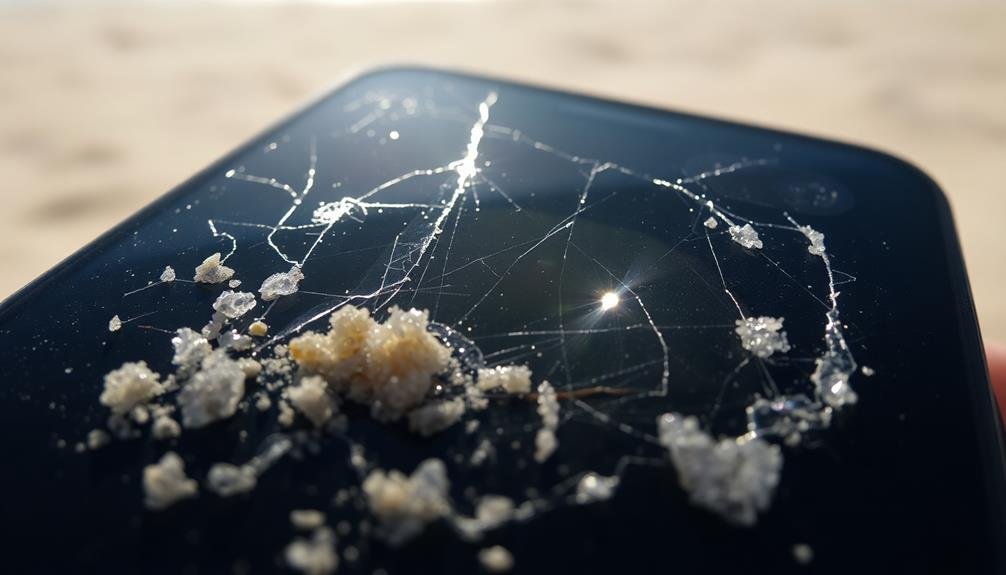
Your phone's camera lens is vulnerable to abrasive particles like sand and salt.
When these tiny grains come into contact with the lens, they can cause scratches that reduce image clarity and quality.
Repeated exposure or more severe incidents can lead to permanent lens damage, potentially ruining your phone's camera functionality.
Abrasive Particles Cause Scratches
How do those tiny grains of sand and salt wreak such havoc on your phone's camera? It's all about their abrasive nature.
These particles are surprisingly hard and sharp, often harder than the materials used in your phone's camera lens and protective glass.
When sand or salt comes into contact with your device, they act like miniature sandpaper. As you move your phone in and out of your pocket or bag, these particles grind against the lens and screen, creating microscopic scratches.
Over time, these scratches accumulate, leading to visible damage and potentially affecting image quality.
Sand, in particular, is composed of quartz and other minerals that rank high on the Mohs scale of hardness. This means they can easily scratch softer materials like glass and plastic.
Salt crystals, while not as hard as sand, can still cause damage, especially when combined with moisture.
To protect your phone's camera, always keep it in a case when at the beach or in sandy environments.
Clean your device regularly with a soft, lint-free cloth, and consider using a screen protector for added defense against these abrasive particles.
Reduced Image Clarity
Scratching and damaging your phone's camera lens can greatly reduce image clarity. When sand or salt particles scratch the lens, they create tiny imperfections that distort light as it enters the camera. This distortion leads to blurry, hazy, or unfocused images. Even microscopic scratches can considerably impact your photos' quality.
The severity of image degradation depends on the extent of lens damage. Here's a breakdown of how different levels of scratching affect your camera's performance:
| Scratch Level | Impact on Image Quality |
|---|---|
| Micro | Slight loss of sharpness |
| Minor | Noticeable blur in parts |
| Moderate | Overall softness |
| Major | Considerable distortion |
| Severe | Unusable images |
You'll notice reduced contrast, color accuracy, and detail in your photos as scratches accumulate. In low-light conditions, scratches can cause lens flare and unwanted light artifacts. To maintain your phone camera's clarity, always protect it from abrasive materials. Use a lens cover when in sandy or salty environments, and clean your lens gently with a microfiber cloth. If you notice a decline in image quality, consider professional lens repair or replacement to restore your camera's performance.
Permanent Lens Damage
While minor scratches may only affect image quality, severe damage from sand and salt can permanently harm your phone's camera lens. Tiny sand particles act like sandpaper, etching micro-abrasions into the lens surface. Over time, these scratches accumulate, causing light to scatter and reducing overall image sharpness.
Salt crystals pose an equally serious threat. When seawater evaporates on your lens, it leaves behind salt residue. These crystals can scratch the lens and, worse, attract moisture from the air. This creates a corrosive environment that can eat away at the lens coating and even the glass itself.
You'll notice the effects of permanent lens damage through consistently blurry or hazy photos, regardless of cleaning attempts. In severe cases, you might see visible scratches or pitting on the lens surface. Unfortunately, once your lens sustains this level of damage, it's often irreparable. Your only option may be to replace the entire camera module, which can be costly.
To protect your phone's camera, always use a protective case, avoid exposing it to sand and saltwater, and clean it gently with appropriate materials after potential exposure.
Blocked Camera Ports

Over time, sand and salt particles can accumulate in your phone's camera ports, causing significant issues. These tiny particles can block the openings around your camera lens, preventing light from entering properly and compromising image quality.
You'll notice your photos becoming darker, less sharp, or even partially obscured. As sand and salt build up, they can also interfere with your camera's autofocus mechanism. This leads to blurry images and difficulty capturing clear shots, especially in low-light conditions.
The particles may even scratch the delicate components inside the camera port, potentially causing permanent damage. To prevent these issues, always keep your phone in a protective case when at the beach or in sandy environments.
Regularly clean your phone's camera ports using a soft brush or compressed air. Avoid using liquid cleaners, as they can push particles further into the device. If you suspect your camera ports are blocked, don't attempt to clean them with sharp objects, as this could cause more harm.
Instead, seek professional cleaning services to safely remove the debris and restore your camera's functionality. By taking these precautions, you'll help guarantee your phone's camera remains in top condition despite exposure to sand and salt.
Moisture Infiltration Risks

Beyond blocking ports, sand and salt pose a serious moisture infiltration risk to your phone's camera. When these particles come into contact with moisture, they can create a corrosive mixture that seeps into the delicate components of your device. This infiltration can lead to short circuits, electrical damage, and even complete camera failure.
You'll want to be extra cautious when using your phone near the beach or in other sandy, salty environments. Moisture can enter your device through:
- Microscopic gaps in the phone's casing
- The lens assembly
- Charging ports
- Speaker grilles
- SIM card slots
Once inside, this corrosive mixture can wreak havoc on your camera's sensitive electronics. It can erode metal contacts, damage image sensors, and fog up lenses from the inside.
Even if your phone is water-resistant, prolonged exposure to salty or sandy moisture can compromise its seals over time.
To protect your device, always use a protective case and avoid exposing it to these elements whenever possible. If your phone does come into contact with sand or salt water, clean it immediately with fresh water and dry it thoroughly.
Cleaning Techniques for Beach Use
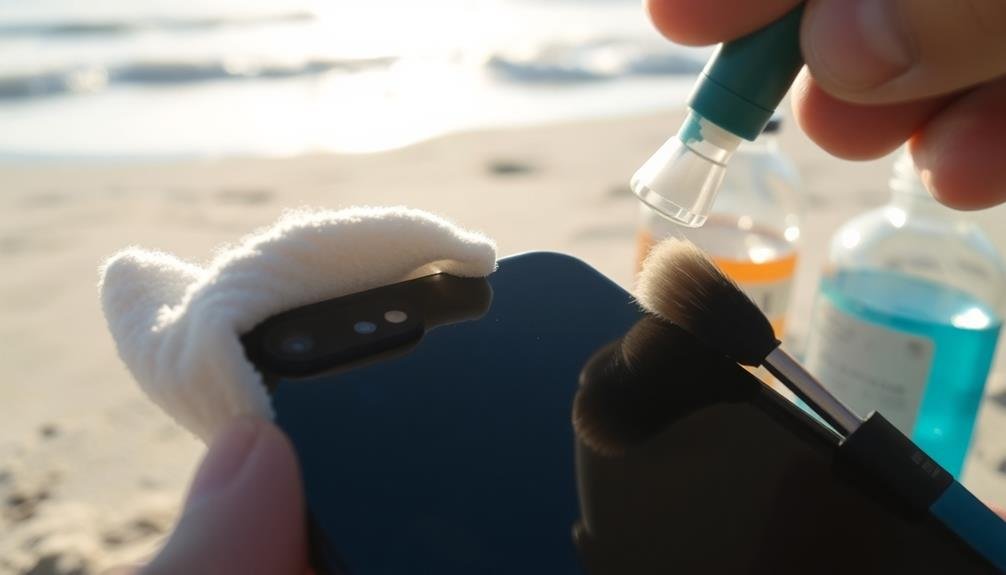
Knowing how to clean your phone after beach exposure is essential for preserving its camera and overall functionality.
Start by gently brushing off any loose sand or debris with a soft-bristled brush. Don't use your fingers, as this can push particles further into crevices.
Next, use a slightly damp microfiber cloth to wipe down the phone's exterior, paying extra attention to the camera lens and surrounding area. Avoid using water directly on the device.
For stubborn salt residue, create a solution of distilled water and isopropyl alcohol (1:1 ratio). Lightly dampen a cloth with this mixture and carefully clean affected areas.
Don't forget to clean your phone case separately. Remove it and wash it thoroughly with mild soap and water, then dry completely before reattaching.
For the charging port and speaker grilles, use compressed air to blow out any trapped particles. Be gentle and hold the can upright to avoid forcing moisture into the phone.
Protective Cases and Accessories

Three essential protective accessories can greatly reduce the risk of sand and salt damage to your phone camera at the beach.
First, invest in a high-quality waterproof case that seals your entire phone, including the camera lens. These cases provide a barrier against water, sand, and salt spray.
Second, consider a lens cover specifically designed for your phone model. It'll shield the camera lens when you're not using it.
Third, pack a microfiber cloth to gently wipe away any salt or sand that manages to reach your phone.
In addition to these essentials, you'll want to:
- Use a phone lanyard to keep your device secure and prevent accidental drops
- Apply a tempered glass screen protector for added defense
- Carry a waterproof dry bag for extra protection when not using your phone
- Invest in a floating phone case if you plan on water activities
- Keep silica gel packets in your beach bag to absorb moisture
Long-Term Camera Performance Impact

Sand and salt's long-term effects on your phone's camera can be devastating if left unchecked. Over time, these abrasive particles can scratch the camera lens, leading to blurry or distorted images.
Even if you don't notice immediate damage, the accumulation of microscopic scratches will gradually degrade your camera's performance. Salt, in particular, can corrode metal components within the camera module, affecting its focusing mechanism and overall functionality.
This corrosion can cause the camera to become sluggish or unresponsive, reducing your ability to capture spontaneous moments.
Repeated exposure to sand and salt can also compromise the waterproof seals around your phone's camera, making it more susceptible to moisture damage. This can result in fogging inside the lens or, worse, complete camera failure.
You'll likely notice a decline in image quality over time, with reduced sharpness, color accuracy, and low-light performance. Your once-crisp photos may appear hazy or lack detail, especially in challenging lighting conditions.
To prevent these issues, regularly clean your phone's camera lens and avoid prolonged exposure to sandy or salty environments. If you suspect damage, consult a professional for repairs before the problems worsen.
Frequently Asked Questions
Can Sand or Salt Damage Other Phone Components Besides the Camera?
Yes, sand and salt can damage other phone components. They can infiltrate your device's ports, speakers, and buttons, causing corrosion and electrical issues. They may also scratch your screen or interfere with your phone's charging capabilities.
Are Waterproof Phones Immune to Sand and Salt Damage?
Even waterproof phones aren't immune to sand and salt damage. While they're better protected, these elements can still scratch screens, clog ports, and interfere with buttons. You'll want to be cautious at the beach, regardless of your phone's rating.
How Quickly Can Sand and Salt Cause Noticeable Camera Deterioration?
You'll notice camera deterioration from sand and salt surprisingly quickly. It can happen in just minutes of exposure. Even a single grain can scratch your lens, while salt residue can corrode components within hours. Don't underestimate their damaging effects!
Does Phone Insurance Typically Cover Sand and Salt-Related Camera Damage?
You'll need to check your specific policy, but most standard phone insurance plans don't cover sand or salt damage. It's often considered accidental or environmental damage, which isn't typically included. You might need additional coverage for this.
Can Professional Cleaning Services Restore a Sand or Salt-Damaged Phone Camera?
Professional cleaning services might restore your sand or salt-damaged phone camera, but it's not guaranteed. You're better off preventing damage in the first place. If cleaning doesn't work, you'll likely need to replace the camera module entirely.
In Summary
You've learned why sand and salt are your phone camera's worst enemies. They can scratch lenses, clog ports, and cause corrosion. But don't worry, you're not helpless. With proper protective cases, careful cleaning, and smart beach habits, you can keep your camera safe. Remember, prevention is key. By taking precautions, you'll guarantee your phone's camera stays in top shape, capturing those beach memories for years to come.


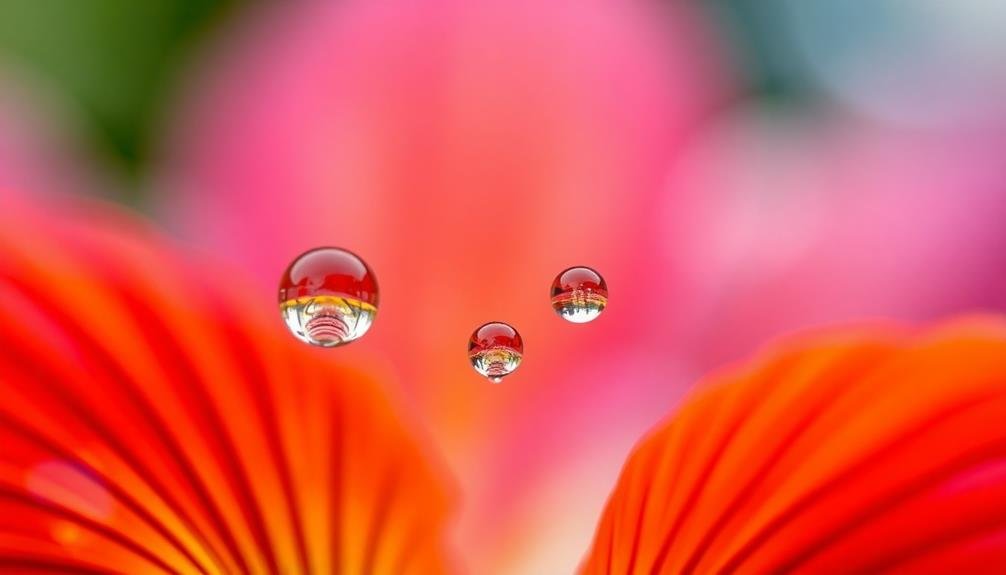
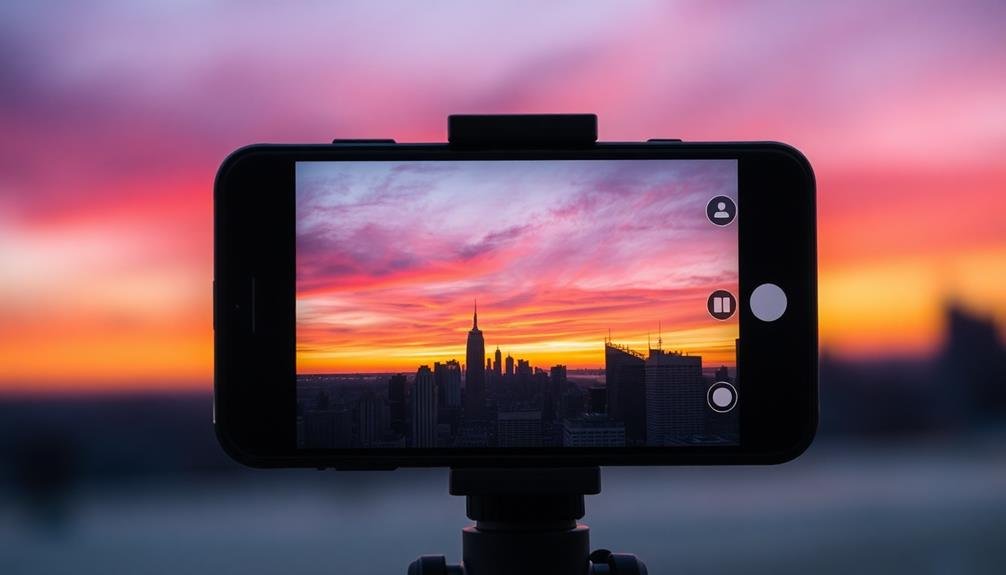

Leave a Reply